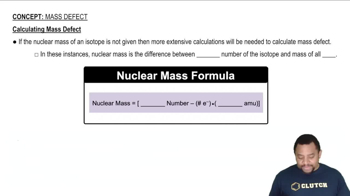Here are the essential concepts you must grasp in order to answer the question correctly.
Nuclear Decay Processes
Nuclear decay processes, such as electron capture and beta-plus (β+) decay, involve the transformation of unstable nuclei into more stable forms. In electron capture, an electron is absorbed by a proton, converting it into a neutron and emitting a neutrino. In β+ decay, a proton is transformed into a neutron, emitting a positron and a neutrino. Understanding these processes is crucial for analyzing the energy changes associated with nuclear reactions.
Recommended video:
Energy Release in Nuclear Reactions
The energy released during nuclear reactions is determined by the mass difference between the reactants and products, as described by Einstein's equation E=mc². When a nuclide undergoes decay, the mass of the resulting particles is often less than that of the original nuclide, and this mass defect is converted into energy. Calculating the energy released in different decay processes allows for a comparison of their efficiencies and impacts.
Recommended video:
Atomic Mass and Mass Defect
Atomic mass is a measure of the mass of an atom, typically expressed in atomic mass units (amu). The mass defect refers to the difference between the total mass of the individual nucleons and the actual mass of the nucleus, which accounts for the binding energy that holds the nucleus together. In decay calculations, knowing the atomic masses of the involved nuclides is essential for determining the mass defect and, consequently, the energy released during the decay.
Recommended video:
 Verified step by step guidance
Verified step by step guidance


